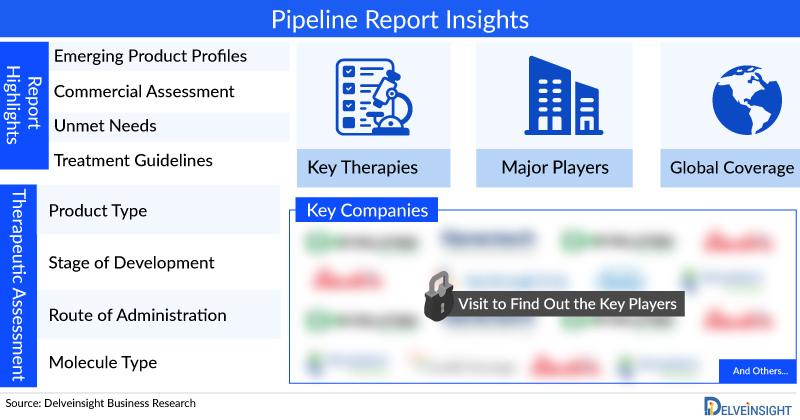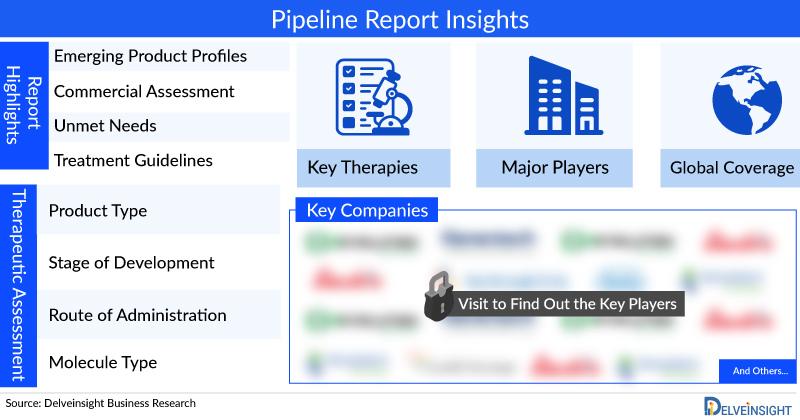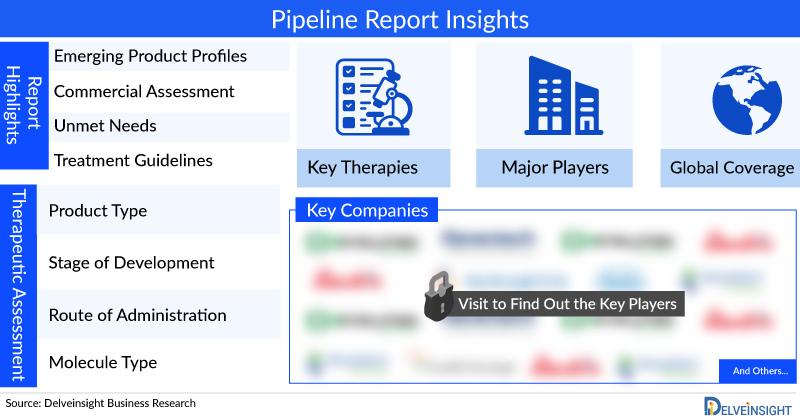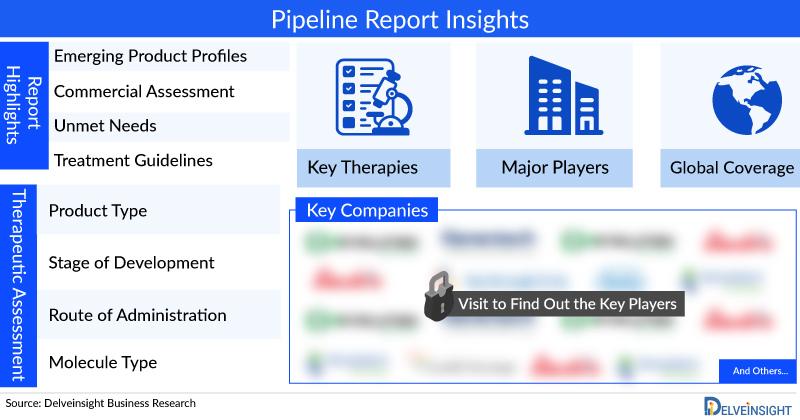Press release
Cytokine Release Syndrome Pipeline Insight 2025: Advancing Therapeutics to Manage CAR-T-Associated Toxicities and Beyond
Cytokine Release Syndrome (CRS) is a life-threatening systemic inflammatory response often associated with CAR-T cell therapies and other immunotherapies. It is characterized by a surge of cytokines, including IL-6 and IFN-γ, leading to symptoms ranging from mild flu-like illness to severe multi-organ dysfunction. As cell and gene therapies continue to expand across oncology and autoimmune indications, addressing CRS has become a top priority for both safety and treatment sustainability.The current standard of care revolves around immunosuppressants such as corticosteroids and IL-6 inhibitors like tocilizumab. While these agents help mitigate symptoms, they may also blunt the therapeutic efficacy of the underlying treatment. This limitation has led to a growing pipeline of candidates aiming for more selective modulation of the immune response. Agents targeting GM-CSF, IL-1, and novel checkpoints are under early clinical evaluation, with the goal of curbing inflammation while preserving antitumor activity.
By 2025, over a dozen active programs will be underway globally, exploring diverse modalities such as monoclonal antibodies, kinase inhibitors, and engineered cellular therapies with built-in safety switches. Several biotech companies and academic collaborations are also developing predictive biomarkers and AI-based risk assessment tools to guide early intervention and personalized CRS management.
Despite challenges related to trial design, patient heterogeneity, and regulatory pathways, the expanding CRS pipeline reflects the urgency to enhance the safety of next-gen immunotherapies. With targeted interventions and preventive strategies gaining traction, the landscape is shifting toward safer and more predictable treatment paradigms in immuno-oncology and beyond.
Interested in learning more about the current treatment landscape and the key drivers shaping the cytokine release syndrome pipeline? Click here: https://www.delveinsight.com/report-store/cytokine-release-syndrome-pipeline-insight?utm_source=openpr&utm_medium=pressrelease&utm_campaign=jpr
Key Takeaways from the Cytokine Release Syndrome Pipeline Report
• DelveInsight's cytokine release syndrome pipeline analysis depicts a strong space with 5+ active players working to develop 5+ pipeline drugs for cytokine release syndrome treatment.
• The leading cytokine release syndrome companies include Biocon Limited, Olatec Therapeutics LLC, Novartis Pharmaceuticals, and others are evaluating their lead assets to improve the cytokine release syndrome treatment landscape.
• Key cytokine release syndrome pipeline therapies in various stages of development include LUM001, A4250, and others.
• In August 2025, the FDA has approved an expanded label for AVTOZMA® (tocilizumab‐anoh) intravenous formulation to now include treatment of CRS in both adults and children aged 2 and older. This expanded approval aligns AVTOZMA IV with all authorized indications and is expected to improve access to biologic therapy for CRS management.
• In June 2025, in a major regulatory shift, the FDA eliminated the REMS (Risk Evaluation and Mitigation Strategy) requirement for approved CAR‐T cell therapies, including breyanzi, yescarta, and others. This change removes the additional administrative burden while retaining existing boxed warnings for CRS and neurologic toxicities, potentially expanding accessibility to these therapies.
• In March 2025, a retrospective analysis published in Blood Advances revealed that siltuximab significantly reduced the severity of both CRS and immune effector cell‐associated neurotoxicity syndrome (ICANS) in patients following CAR‐T cell therapy. This finding has prompted the initiation of a Phase II prospective trial to evaluate siltuximab's benefits in this setting.
Request a sample and discover the recent breakthroughs happening in the cytokine release syndrome pipeline landscape at https://www.delveinsight.com/report-store/cytokine-release-syndrome-pipeline-insight?utm_source=openpr&utm_medium=pressrelease&utm_campaign=jpr
Cytokine Release Syndrome Overview
Cytokine Release Syndrome (CRS) is a systemic inflammatory response triggered by the rapid release of cytokines from immune cells. It commonly occurs as a side effect of certain immunotherapies, such as CAR-T cell therapy and monoclonal antibodies. Symptoms range from mild flu-like signs-fever, fatigue, and headache-to severe reactions like hypotension, respiratory distress, and multi-organ failure. CRS severity varies, requiring careful monitoring and management. Treatment typically involves supportive care and immunosuppressive agents like corticosteroids or cytokine blockers (e.g., tocilizumab) to reduce inflammation and prevent complications. Early recognition is crucial to improving patient outcomes.
Find out more about cytokine release syndrome medication at https://www.delveinsight.com/report-store/cytokine-release-syndrome-pipeline-insight?utm_source=openpr&utm_medium=pressrelease&utm_campaign=jpr
Cytokine Release Syndrome Treatment Analysis: Drug Profile
Canakinumab: Novartis
Canakinumab is an interleukin-1β (IL-1β) blocker approved for treating certain periodic fever syndromes, including cryopyrin-associated periodic syndromes and systemic juvenile idiopathic arthritis. Novartis is conducting the Phase III CAN-COVID trial to assess its effectiveness against cytokine release syndrome (CRS) associated with COVID-19 pneumonia.
Itacitinib: Incyte Corporation
Itacitinib is a selective and potent JAK1 inhibitor under clinical evaluation for various inflammatory conditions. It is currently in Phase II trials for preventing cytokine release syndrome induced by immune effector cell therapies.
Learn more about the novel and emerging cytokine release syndrome pipeline therapies at https://www.delveinsight.com/report-store/cytokine-release-syndrome-pipeline-insight?utm_source=openpr&utm_medium=pressrelease&utm_campaign=jpr
Cytokine Release Syndrome Therapeutics Assessment
By Product Type
• Mono
• Combination
• Mono/Combination.
By Stage
• Late-stage products (Phase III)
• Mid-stage products (Phase II)
• Early-stage product (Phase I) along with the details of
• Pre-clinical and Discovery stage candidates
• Discontinued & Inactive candidates
By Route of Administration
• Infusion
• Intradermal
• Intramuscular
• Intranasal
• Intravenous
• Oral
• Parenteral
• Subcutaneous
By Molecule Type
• Gene therapies
• Small molecule
• Vaccines
• Polymers
• Peptides
• Monoclonal antibodies
Scope of the Cytokine Release Syndrome Pipeline Report
• Coverage: Global
• Key Cytokine Release Syndrome Companies: Biocon Limited, Olatec Therapeutics LLC, Novartis Pharmaceuticals, and others.
• Key Cytokine Release Syndrome Pipeline Therapies: LUM001, A4250, and others.
To dive deep into rich insights for drugs used for cytokine release syndrome treatment, visit: https://www.delveinsight.com/report-store/cytokine-release-syndrome-pipeline-insight?utm_source=openpr&utm_medium=pressrelease&utm_campaign=jpr
Table of Contents
1. Introduction
2. Executive Summary
3. Cytokine Release Syndrome Pipeline: Overview
4. Analytical Perspective In-depth Commercial Assessment
5. Cytokine Release Syndrome Pipeline Therapeutics
6. Cytokine Release Syndrome Pipeline: Late-Stage Products (Phase III)
7. Cytokine Release Syndrome Pipeline: Mid-Stage Products (Phase II)
8. Cytokine Release Syndrome Pipeline: Early Stage Products (Phase I)
9. Therapeutic Assessment
10. Inactive Products
11. Company-University Collaborations (Licensing/Partnering) Analysis
12. Key Companies
13. Key Products
14. Unmet Needs
15. Market Drivers and Barriers
16. Future Perspectives and Conclusion
17. Analyst Views
18. Appendix
Contact Us:
Jatin Vimal
jvimal@delveinsight.com
+14699457679
Healthcare Consulting
https://www.delveinsight.com/consulting-services
About DelveInsight
DelveInsight is a leading Business Consultant and Market Research firm focused exclusively on life sciences. It supports Pharma companies by providing comprehensive end-to-end solutions to improve their performance. Get hassle-free access to all the healthcare and pharma market research reports through our subscription-based platform, PharmDelve.
This release was published on openPR.
Permanent link to this press release:
Copy
Please set a link in the press area of your homepage to this press release on openPR. openPR disclaims liability for any content contained in this release.
You can edit or delete your press release Cytokine Release Syndrome Pipeline Insight 2025: Advancing Therapeutics to Manage CAR-T-Associated Toxicities and Beyond here
News-ID: 4137299 • Views: …
More Releases from DelveInsight

X-Linked Adrenoleukodystrophy Pipeline Insight 2025: A New Era of Gene Therapy a …
X-Linked Adrenoleukodystrophy (X-ALD) is a rare, inherited metabolic disorder caused by mutations in the ABCD1 gene, leading to the accumulation of very long-chain fatty acids (VLCFAs) that damage the adrenal cortex and white matter of the brain. The disorder predominantly affects males and manifests in multiple phenotypes, including the severe childhood cerebral form, adrenomyeloneuropathy (AMN), and Addison-only disease. Without timely intervention, cerebral X-ALD can progress rapidly, leading to severe neurological…

Biliary Atresia Pipeline Insight 2025: Emerging Regenerative and Anti-Fibrotic T …
Biliary atresia is a rare and life-threatening pediatric liver disease characterized by progressive fibro-obliteration of the bile ducts, leading to cholestasis, fibrosis, and ultimately liver failure. Typically diagnosed within the first few months of life, the condition is managed initially through the Kasai portoenterostomy. However, in many cases, this surgical intervention only delays the need for liver transplantation, which remains the definitive treatment.
As of 2025, the drug development landscape for…

Familial Chylomicronemia Syndrome Pipeline Insight 2025: RNA Therapies and Gene …
DelveInsight's "Familial Chylomicronemia Syndrome - Pipeline Insight, 2025" offers a comprehensive overview of the rapidly advancing therapeutic landscape targeting this ultra-rare autosomal recessive disorder, characterized by extreme hypertriglyceridemia and recurrent pancreatitis due to lipoprotein lipase (LPL) deficiency or dysfunction.
The 2025 pipeline is led by novel RNA interference (RNAi) and antisense oligonucleotide (ASO) therapies designed to silence key regulators of triglyceride metabolism, such as APOC3 and ANGPTL3. Ionis Pharmaceuticals' olezarsen (targeting…

High-Grade Glioma Pipeline Insight 2025: Over 150+ Therapies Target Aggressive B …
High-grade gliomas (HGGs), including glioblastoma multiforme (GBM), represent some of the most aggressive and treatment-resistant brain tumors in oncology. Characterized by rapid progression, poor prognosis, and limited response to conventional therapies, these malignancies continue to pose a major clinical challenge. Despite aggressive surgical resection, radiation, and chemotherapeutic regimens, median survival remains dismal-particularly in GBM, where it typically ranges between 12 and 15 months post-diagnosis.
As of 2025, the global high-grade glioma…
More Releases for Cytokine
Cytokine Market Growth Rate, Demands, Status and Application Forecast by 2031
The global cytokine market size was valued at USD 71.9 billion in 2022 and is expected to register a CAGR of 8.40% during the forecast period.
Get a Free Sample PDF@ https://www.datalibraryresearch.com/sample-request/cytokine-market-5015
The Cytokine Market research report lays emphasis on primary as well as secondary drivers, leading market segments, market share, regional analysis, and possible sales volume. It gives a detailed explanation on what the market definition, applications, classifications, market trends,…
Emerging Trends Influencing The Growth Of The Cytokine Release Syndrome Treatmen …
The Cytokine Release Syndrome Treatment Market Report by The Business Research Company delivers a detailed market assessment, covering size projections from 2025 to 2034. This report explores crucial market trends, major drivers and market segmentation by [key segment categories].
How Big Is the Cytokine Release Syndrome Treatment Market Size Expected to Be by 2034?
The market size for the treatment of cytokine release syndrome has experienced remarkable growth recently. The market value…
Cytokine Release Syndrome Management Market Know the Scope and Trends
InsightAce Analytic Pvt. Ltd. announces the release of a market assessment report on the " Cytokine Release Syndrome Management Market - (By Cytokine Type (Tumor Necrosis Factor-TNF, Interleukins-II, Interferons-IFN, Epidermal Growth Factor-EGF), By Therapeutic Application (Cancer, Asthma, Airway Inflammation, Arthritis, Others), By Biomarker Type (Interleukin-10, Interleukin-6, Ferritin, Cluster of Differentiation-163), By Route of Administration (Oral, Intravenous), By End User (Hospitals, Specialty Clinics, Others)), Trends, Industry Competition Analysis, Revenue and Forecast…
Key Driver Shaping the Future Cytokine Release Syndrome Treatment Market From 20 …
What Is the Estimated Market Size and Growth Rate for the Cytokine Release Syndrome Treatment Market?
In recent times, the market size for treatments of cytokine release syndrome has seen a rapid increase. The forecast predicts an upsurge from $1.25 billion in 2024 to $1.42 billion in 2025, presenting a compound annual growth rate (CAGR) of 13.7%. A growth surge during the historical period can be credited to factors such as…
Cytokine Detection Reagents Market Revenue, Insights, Overview, Outlook, Analysi …
Cytokine Detection Reagents Market
Cytokine detection reagents are substances used in laboratory settings to detect and measure the presence and levels of cytokines in biological samples. Cytokines are small proteins secreted by cells of the immune system that play crucial roles in cell signaling and immune responses. They regulate inflammation, immunity, and various other physiological processes.
Cytokine detection reagents typically include antibodies, ELISA (enzyme-linked immunosorbent assay) kits, multiplex assays, and other molecular…
Cytokine Market Size, Share, Growth Report and Forecast 2024-2032
According to the report by Expert Market Research (EMR), the global cytokine market is projected to grow at a CAGR of 6% between 2024 and 2032. Aided by the burgeoning applications in medical and research fields, the market is expected to grow significantly by 2032.
Cytokines are a broad category of small proteins that are crucial in cell signalling. Their role is primarily related to immune and inflammatory responses. These proteins…
